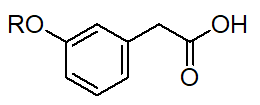Overview
The present invention relates to esthers of 3-hydroxyphenyacetic acid and their use to treat narcolepsy and other sleep disorders. Gamma-hydroxybutyric acid (GHB) is a known agonist for the GHB receptor. Unfortunately it also acts at GABA receptors directly and through its metabolization into alpha aminobutyric acid (GABA). As a result, GHB is abused for its euporigenic effects. The investigators have designed several analogs of GHB that lack any GABAergic activity. These new chemcial entities (NCE) represent GHB active therapeutics which act exclusively with GHB receptors and therefore lack the euporigenic activity of GHB.
The inventors have created a series of compounds having the general structure shown. The functional group R can be either an aromatic group or arylalkyl substituent. The 3-esthers of 3-hydroxyphenylacetic acid claimed in U.S. Patent 7,838,556 were shown to have a high affinity at GHB sites, no significant affinity at GABA receptors and were not rapidly metabolized to GABAergic ligands. The lack of GABA affinity makes these compounds excellent candidates for treating sleep disorders through GHB receptor binding.
Applications
Narcolepsy is a profoundly disabling, life-long sleep disorder characterized by excessive daytime sleepiness (hypersomnia), often in association with cataplexy. Narcolepsy has an estimated prevalence in the United States of between one in 2,000. It is estimated that only 25% of narcolepsy patients have been diagnosed to date.
Therapeutics to treat narcolepsy are either designed to reduce excessive sleepiness or are REM-suppressing. REM-supressing drugs are used to reduce the systems of cataplexy, hallucinations and sleep paraylysis.
It is expected that the global market for narcolespy therapeutics will reach $2.0 billion dolars by 2020. The market for narcolepsy therapeutics is growing at 2.8% CAGR.
Advantages
Benefits of GHB in treating sleep disordres without potential for abuse.
Stage of Development
Two lead compounds have been identified having the general structure shown above. Additional new chemical entities are being developed and behavioral assay studies planned.
Licensing Potential
Narcolepsy is a profoundly disabling, life-long sleep disorder characterized by excessive daytime sleepiness (hypersomnia), often in association with cataplexy. Narcolepsy has an estimated prevalence in the United States of between one in 2,000. It is estimated that only 25% of narcolepsy patients have been diagnosed to date.
Therapeutics to treat narcolepsy are either designed to reduce excessive sleepiness or are REM-suppressing. REM-supressing drugs are used to reduce the systems of cataplexy, hallucinations and sleep paraylysis.
It is expected that the global market for narcolespy therapeutics will reach $2.0 billion dolars by 2020. The market for narcolepsy therapeutics is growing at 2.8% CAGR.
Contact Info
Office of Technology Transfer
620 W Lexington St., 4th Floor
Baltimore, MD 21201
Email: [email protected]
Phone: (410) 706-2380